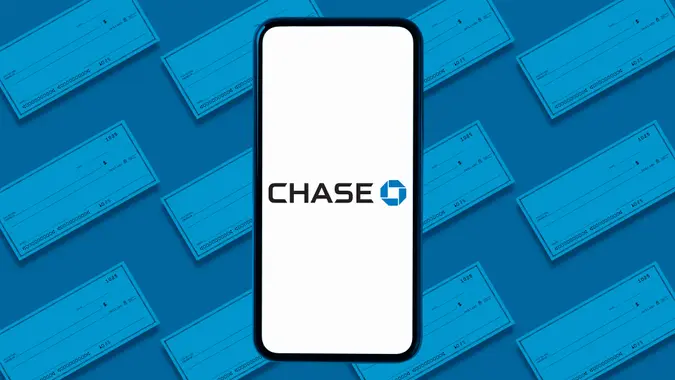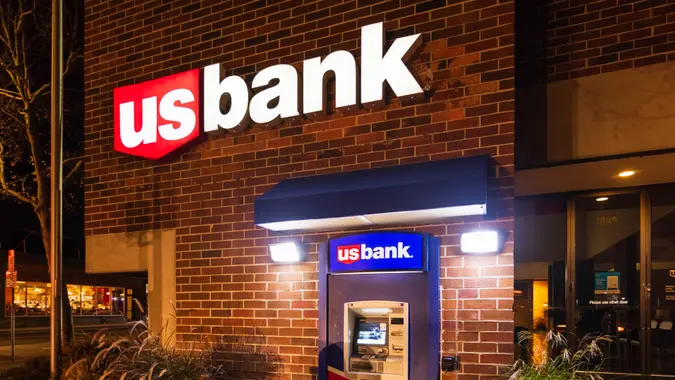Best Joint Checking Accounts of 2025

Commitment to Our Readers
GOBankingRates' editorial team is committed to bringing you unbiased reviews and information. We use data-driven methodologies to evaluate financial products and services - our reviews and ratings are not influenced by advertisers. You can read more about our editorial guidelines and our products and services review methodology.

20 Years
Helping You Live Richer

Reviewed
by Experts

Trusted by
Millions of Readers
Sometimes more than one person needs or wants to have access to the same funds. In these cases, it makes sense to open a joint checking account.
A joint checking account is simply a bank account with more than one owner. You can usually open any type of bank account jointly, either in person or online.
Best Joint Checking Accounts
The factors that make a joint checking account a good choice are often the same as they are for an individual account — a good interest rate, low or no fees, no minimum balance and so forth. Think about which of these is most important to you before you decide where to open your joint account.
Here are some of the best joint checking accounts for:
- SoFi®: Best for earning interest
- Capital One: Best for parents and teens
- Ally Bank: Best for online-only banking
- Axos Bank: Best for couples
- NBKC: Best for combined checking and savings
SoFi
- Best for: Earning interest
Why We Picked It
Sofi’s Checking and Savings account is the best of both worlds — offering users a combined checking and savings account that pays a high APY on both balances with requirements that are easy to meet.
Key Features
- Annual Percentage Yield. 0.50% (checking) and up to 4.20% (savings account with direct deposits or $5,000 in monthly deposits)
- Minimum Deposit Requirement. None
- Monthly Maintenance Fees. None
Pros
- No account fees
- Good remote customer service options
- No-fee overdraft coverage
Cons
- Overdraft coverage limited to just $50 in debit card purchases
- Overdraft coverage only available with $1,000 in direct deposits
Account Overview
Sofi’s online banking account pays APY on checking balances. It also pays up to APY on money that’s earmarked for savings as long as you receive monthly direct deposits.
If you don’t meet direct deposit requirements, the savings portion of your balance will earn a much lower APY. Additionally, there are no account fees and fee-free overdraft protection, which means your money will stay in your banking account where it belongs.
Capital One
- Best for: Parents and teens
Why We Picked It
Capital One’s MONEY Teen Checking account gives parents and teens their own access to the mobile app with separate logins. Teens can manage their money while parents can see what’s going on.
Key Features
- Annual Percentage Yield. on your balance
- Minimum Deposit Requirement. None
- Monthly Maintenance Fees. None
Pros
- Parents don’t need a Capital One account; any linked bank account works
- No account fees or minimums
- Lost debit cards can be locked through the app
- Account is interest-bearing
Cons
- Low APY
- Limited branches
Account Overview
With the MONEY Teen Checking account, parents can deposit their child’s weekly or monthly allowance and even freeze their debit cards if spending gets out of control.
It’s called a “teen” account, but it can actually be used for kids as young as 8. However, the account has low interest at just APY — you’ll need to open a 360 Performance Savings account for better interest. If you do, you’ll earn APY on any balance.
Ally Bank
- Best for: Online-only banking
Why We Picked It
If you don’t mind doing all your banking online, Ally Bank’s Spending Account offers a fee-free, interest-bearing checking option with no minimum balance requirements and some extra perks.
Key Features
- Annual Percentage Yield. 0.10% if balance is below $15,000 and 0.25% if your balance is above $15,000
- Minimum Deposit Requirement. None
- Monthly Maintenance Fees. None
Pros
- $10 ATM reimbursement per statement cycle
- Spending buckets to help manage money
- Early direct deposit
- No maintenance or overdraft fees
Cons
- Online-only bank
- Less competitive APY
Account Overview
Ally Bank’s Spending Account pays APY — not a lot, but better than what many big banks offer, like Wells Fargo. You can add a savings account and get APY on that money.
Linking savings and checking lets you easily move money and analyzes your spending to reveal savings opportunities. The checking account also offers early direct deposit, which allows you to get your pay two days early, and if you use out-of-network ATMs, you’ll receive up to $10 in reimbursements each statement cycle.
Axos Bank
- Best for: Couples
Why We Picked It
The Axos Rewards Checking account is a good option for a joint account for couples. Many of the actions required to earn the maximum APY make sense for couples who have combined their finances — though individuals can also meet the requirements.
Key Features
- Annual Percentage Yield. Up to on your balance
- Minimum Deposit Requirement. None
- Monthly Maintenance Fees. None
Pros
- High APY
- No monthly maintenance or overdraft fees
- All domestic ATM fees are reimbursable
Cons
- Bonus and interest requirements could be difficult to meet
- Online-only bank
Account Overview
Although a $500 bonus for opening the Axos Rewards Checking account sounds great, the requirements might be difficult to meet if you don’t have a joint account. You must have a minimum of $1,500 in monthly direct deposits for the first seven months and maintain a $3,000 average daily balance.
Additionally, earning the full amount of interest offered on the account requires you to complete a handful of qualifying activities:
- Set up direct deposit totaling $1,500 or more.
- Use your debit card for 10 transactions a month.
- Keep $2,500 or more in a managed investment portfolio.
- Have $2,500 in a self-directed trading account.
- Make your Axos loan payment directly from your checking account.
If you do all these things, you could be earning APY on your checking balance. If you do only some, your APY will reduce with each activity you’re missing. It’s a lot to keep track of, but that rate on checking is hard to beat.
NBKC Bank
- Best for: Combined checking and savings
Key Features
- Annual Percentage Yield. 1.75% on your balance
- Minimum Deposit Requirement. None
- Monthly Maintenance Fees. None
Why We Picked It
The NBKC Bank Everything Account is a combined checking and savings option that allows you to address a wide variety of banking tasks, including spending, saving, tracking and earning without account-draining fees.
Pros
- ATM fee reimbursements
- Built-in, customizable savings goals
- No monthly maintenance fees or overdraft fees
Cons
- Smaller ATM network compared to some other banks
- Branch availability limited to Kansas City
Account Overview
NBKC Bank has an Everything Account, which combines savings and checking. The account offers APY on all savings balances, and there’s no minimum balance required. You get free access to 37,000 ATMs and reimbursement of up to $12 per month if you use out-of-network ATMs. You can easily move money from checking to savings and vice versa.
Why Open a Joint Checking Account?
Joint accounts make sense for couples who have combined their finances or plan to and want equal access to the funds in their checking, savings and CD accounts. This sharing of funds often makes it easier for couples to talk about money, manage expenses and set goals for their financial future.
But joint accounts aren’t for couples only. There are a lot of other situations in which a joint account makes sense.
For parents, opening joint accounts with their teenagers or young-adult kids makes it easier to teach them about managing money. It also allows some control over the funds. For adults who have responsibility for an aging parent, having a joint account can make it easier for the caregiver to access funds for the elder’s needs.
Why Couples, Families and Business Partners Use Joint Checking Accounts
Joint checking accounts are popular for couples, families and business partners because it helps with shared financial management and offers transaction transparency. Let’s take a look at some reasons why joint checking accounts are convenient for more couples, families and business partners:
Couples
- Shared Expenses. Couples can plan for monthly expenses like rent, groceries and utilities. With both individuals on the account, budgeting becomes easier.
- Building Financial Trust. Having full visibility regarding accounting details makes it easier for couples to build financial trust.
- Quick Access to Emergency Funds. If one person needs to access funds quickly, a joint checking account allows immediate withdrawal opportunities.
Families
- Managing Family Expenses. Families often use joint accounts for expenses related to children, healthcare, vacations, and household bills. A joint account centralizes funds, making it easier to track where money is going.
- Parental Oversight. If you have a joint checking account with your teen, you can monitor all expenses.
- Elderly Care Finance Management. In cases where adult children need to manage finances for aging parents, joint accounts allow for direct access, ensuring bills and expenses are paid promptly.
Business Partners
- Operational Efficiency. Business partners need equal access to a joint checking account to manage finances, pay bills and collect payments.
- Transparency. Having a joint checking account allows both business partners to monitor expenses and income.
- Access to Funds: In the event that one partner is unavailable, the other can still access funds to handle critical business expenses, ensuring continuity.
Benefits of Joint Checking Accounts
Joint checking accounts offer several benefits. Here are those benefits:
- Makes it easy to manage shared expenses. With a single account for shared expenses, it makes it easier to pay bills timely and budget for expenses.
- Improves financial transparency. Since both parties have access to the account at all times it is easy to see each other’s contribution and expenses into the account.
- Convenient access for all. Both account holders have immediate access to make deposits and withdrawals. Having quick access to the account makes it easier to pay for unexpected expenses and emergencies.
- Shared savings and goal setting. With each person on the account having a broad overview of funds, it is easier to make goals for saving money.
- Ease for financial management for dependents. If you have children or are taking care of an elderly individual, access to finances makes it easier to support dependents’ finances.
- Survivorship benefits. In cases where joint accounts are set up with rights of survivorship, the remaining account holder gains immediate access to the funds if the other account holder passes away. This can provide critical financial stability during difficult times.
Potential Drawbacks and Risks to Consider
Joint checking accounts come with some drawbacks too. Here are special risks to consider when dealing with an account holder on a joint checking account:
- Loss of privacy. Since each account holder is on the account finances are on full display and each person can view income and spending habits.
- Unequal contributions to the account. If one person is contributing more to the account than the other, it could lead to resentment between account holders.
- Potential overdrafts. If there is not enough money and the account goes into overdraft, it is possible to incur fees even if you weren’t the offending party.
- Debt risks. All parties are responsible for fees on the account. If these fees go unpaid, both parties could be affected by a dip in their credit rating.
- Risk of fraud. Since both parties are on the account, there is a risk that one party misuses funds without the other’s knowledge.
- Possible tax implications. If there is a large deposit in your joint checking account by one party, it could trigger tax questions from the IRS.
- Legal liability. Both account holders are legally responsible for the account, including any debts, overdrafts, or fees incurred. If one person withdraws money without the other’s consent or fails to maintain the balance, both parties bear the financial and legal consequences.
How to Open a Joint Checking Account
It is pretty easy to open a joint checking account. Here is a snapshot of the process:
- Find a bank or credit union. Look for a bank that provides the best features for a joint checking account.
- Decided on features. You may want a joint checking account with cashback rewards or special benefits.
- Gather necessary documents. You will likely need your driver’s license, social security card, proof of address and pay stub indicating your income.
- Visit a bank or apply online. You can generally set up your account in person or visit the bank’s website online.
- Specify the type of account/rights. You can set up your account with “right of survivorship” so that when one account holder passes, the other retains access to the funds.
- Fund the account. After you open the account, you must deposit funds. Most banks require a minimum account.
Tips for Managing a Joint Checking Account Successfully
Ownership of a joint checking account can be tricky. However, if you have ground rules, you can potentially avoid conflicts regarding your joint checking account. Here are some tips to manage your joint checking account successfully:
- Discuss the purpose of the joint checking account. Have a conversation on what you intend to accomplish with the account so that everyone has clear expectations on its purpose.
- Communicate regularly. Communicate with your joint account holder to avoid any mistrust or conflicts in the long-term.
- Establish spending guidelines. Have an agreement on what each individual can spend without conferring with the other account holder prior to the transaction.
- Assign responsibility for specific expenses. In order to avoid misunderstandings on who should pay what and when, establish those guidelines when you establish your joint checking account.
- Review statements regularly. Look over transactions, check for any unusual activity, and make sure both parties are satisfied with how the funds are being used.
Final Takeaway
Take a few extra minutes to compare the features of available accounts. Consider what is most important to you and the other account holder to help you determine which joint account is best for your specific situation.
FAQ
Here are the answers to some common questions about joint bank accounts.- Can a joint checking account be converted to an individual account?
- Yes. You can convert a joint checking account to an individual account. You need to contact the bank on their policies to convert a joint checking account to an individual account. In most cases, both account holders would need to consent to the conversion.
- What happens to the joint checking account if one account holder passes away?
- The way the account is handled depends on its setup. If the account includes "rights of survivorship" the surviving account holder generally becomes the sole owner of the account and gains access to all funds. If the account does not include rights of survivorship, the account may have to go through the probate process.
- Can my wife empty out our joint checking account?
- Yes. Either account holder on a joint checking account has full access to the funds and can withdraw money without the other person's consent.
Rudri Patel, Daria Uhlig and Cynthia Measom contributed to the reporting for this article.
*Capital One interest rates accurate as of 11/4/2025. See website for all current rates.
Rates are subject to change; unless otherwise noted, rates are updated periodically. All other information on accounts is accurate as of 4/7/2025.
Editorial Note: This content is not provided by any entity covered in this article. Any opinions, analyses, reviews, ratings or recommendations expressed in this article are those of the author alone and have not been reviewed, approved or otherwise endorsed by any entity named in this article.
GOBankingRates is a personal finance and consumer interest rate website and an online marketing company serving top-tier banks, credit unions and other financial services organizations. Some companies mentioned in this article might be clients of GOBankingRates, which serves more than 100 national, local and online financial institutions. Rankings and roundups are completely objective, and no institution, client or otherwise, paid for inclusion or specific placement. Any opinions, analyses, reviews or recommendations expressed in this article are those of the author alone and have not been reviewed, approved or otherwise endorsed by the companies included in the article. All fees and rates are subject to change at the issuers’ discretion. Some interest rates might be short-term or promotional offers only, and it is possible additional terms and conditions must be met to obtain the interest rates listed. Rates and availability might vary by region. Verify terms and conditions before opening an account.
GOBankingRates bases its assessment of “best” and “top” products on the above-stated parameters to create a baseline for comparison. This assessment is an approximation of “best” and “top” designed to help consumers find products that might be appropriate for them. There could be other options available as well. Consumers should consider various options appropriate for their circumstances.
Our in-house research team and on-site financial experts work together to create content that’s accurate, impartial, and up to date. We fact-check every single statistic, quote and fact using trusted primary resources to make sure the information we provide is correct. You can learn more about GOBankingRates’ processes and standards in our editorial policy.
- College Data. "FAFSA ASSETS."
 Written by
Written by  Edited by
Edited by 
























